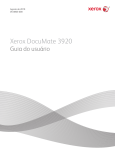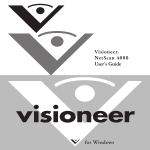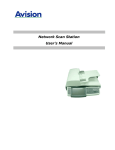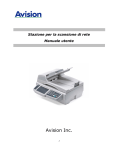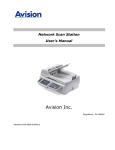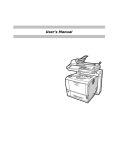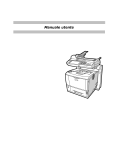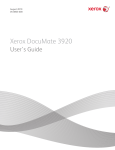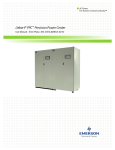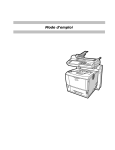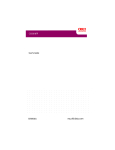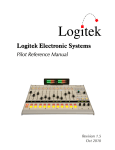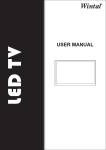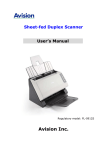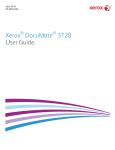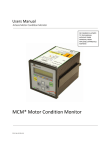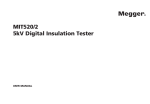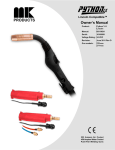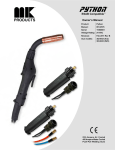Download Network Scan Station User`s Manual
Transcript
Network Scan Station User's Manual Safety Information When using this equipment, the following safety precautions should always be followed. Safety During Operation In this manual, the following important symbols are used: WARNING: Indicates potentially hazardous situations, which if instructions are not followed, could result in death or serious injury. CAUTION: Indicates a potentially hazardous situation which, if instructions are not followed, may result in minor or moderate injury or damage to property. Important: Indicates operational requirements and restrictions. Please read and follow these instructions to ensure a proper operation and to avoid damage to the machine. Note: Indicates further explanation or clarification. Reading this is highly recommended. WARNING: To avoid hazardous electric shock or fire, do not remove any covers or screws other than those specified in this manual. CAUTION: 9 To reduce the risk of fire, use only no.26AWG or larger telecommunication line cord. 9 Disconnect the power plug by pulling the plug, not the cable. 9 Do not touch the metal fingers of the ADF pad module. The edges are sharp and touching them may result in injury. ii Precautions y y y y y Do not install the equipment near heating or air conditioning units. Do not install the equipment in a humid or dusty place. Use only the AC adapter (HEG75-S240320-7L by Hitron) included with the machine. Using other AC adapters may damage the machine and void the warranty. Place the equipment securely on an even, flat surface. Tilted or uneven surfaces may cause mechanical or paper-feeding problems. Retain the box and packing materials for shipping purposes. Notice Important y Do not make copies of any item for which copying is prohibited by law. y Copying the following items are normally prohibited by the local law: y Bank bills, revenue stamps, bonds, stock certificates, bank drafts, checks, passports, driver's licenses. y This machine is equipped with a function that prevents making counterfeit bank bills. Due to this, images similar to bank bills may not be copied properly. Copyrights and Trademarks Ethernet is a registered trademark of Xerox Corporation. Microsoft, Windows, Windows NT, Windows XP, and Windows Vista are registered trademarks of Microsoft Corporation in the United States and/or other countries. Other product names used herein are for identification purposes only and may be trademarks of their respective companies. We disclaim any and all rights to those marks. Warranty The information contained in this document(s) is subject to change without notice. The manufacturer makes no warranty of any kind with regard to this material, including, but not limited to, the implied warranties of fitness for a particular purpose. The manufacturer shall not be liable for errors contained herein or for incidental or consequential damages in connection with the furnishing, performance, or use of this material. iii FCC Radio Frequency Interference Statement This product has been tested and found to comply with the limits for a class B digital device, pursuant to Part 15 of the FCC rules. Operation is subject to the following two conditions: (1) this device may not cause harmful interference, and (2) this device must accept any interference received, including interference that may cause undesired operation. The FCC Class B limits are designed to provide reasonable protection against harmful interference in a residential installation. This equipment generates, uses, and can radiate radio frequency energy and, if not installed and used in accordance with the instructions, may cause harmful interference to radio communications. However, there is no guarantee that interference will not occur in a particular installation. If this equipment does cause harmful interference to radio or television reception, which can be determined by turning the equipment off and on, the user is encouraged to try to correct the interference by one or more of the following measures: Reorient or relocate the receiving antenna. Increase the separation between the equipment and receiver. Connect the equipment into an outlet on a circuit different from that to which the receiver is connected. Consult your point of purchase or service representative for additional suggestions. CE Warning This product satisfies the Class B limits of EN55022, EN55024 and safety requirements of EN 60950. iv Table of Contents 1 Getting Started ......................................................... 1 Introduction ............................................................................................. 1 Features ................................................................................................... 1 External View ........................................................................................... 3 The Front View................................................................................... 3 The Connection Ports ......................................................................... 4 The Control Panel .............................................................................. 5 Preinstallation Information ...................................................................... 7 Internet Communication Features.......................................................... 10 Scan to E-mail.................................................................................. 10 Scan to Network .............................................................................. 11 2 Installing Your Machine.......................................... 12 Minimum Configuration Requirements ................................................... 12 Unlocking the Scan Unit ......................................................................... 13 Connecting the Cables ............................................................................ 14 Connecting the Ethernet Cables ....................................................... 14 Connecting the ADF Cable ................................................................ 14 Connecting the Power and Turning on the Machine ......................... 15 3 Configuring the Machine ......................................... 16 Specifying the Product’s Network Settings............................................. 17 Specifying More Administrator Settings by the Product’s Web Page ...... 20 Editing a Filing Profile by the Product’s Web Page........................... 28 Editing a FTP Profile by the Product’s Web Page.............................. 30 4 Operation ............................................................... 32 Loading Paper ........................................................................................ 33 Notice on Using the ADF .................................................................. 33 Placing Document(s) in the ADF ...................................................... 34 Placing Document(s) on the Glass ................................................... 36 Sending Document to Your Computer on the Network ........................... 37 Basic Operation ............................................................................... 37 Advanced Operation......................................................................... 38 Sending Document to FTP Servers.......................................................... 40 Basic Operation ............................................................................... 40 Advanced Operation......................................................................... 41 Making Copies ........................................................................................ 43 Basic Operation ............................................................................... 43 Advanced Operation......................................................................... 44 Sending Document via E-mails ............................................................... 45 Basic Operation ............................................................................... 45 Advanced Operation......................................................................... 46 v 5 Troubleshooting...................................................... 48 Information Message ..............................................................................48 Information Messages During Scanning and Copying ...................... 48 Information Messages During Networking ...................................... 50 Information Messages During E-Mailing .......................................... 51 Information Messages During Filing................................................ 53 Clearing a Paper Jam ..............................................................................56 Removing the Abnormal Line On Your Scanned Image ...........................58 6 Maintaining Your Machine....................................... 59 Cleaning the Glass ..................................................................................59 Cleaning the LCD-display ........................................................................60 Cleaning the ADF ....................................................................................61 Replacing the ADF Snap-in Pad Module...................................................62 Appendix ..................................................................... 63 Managing the Address Book....................................................................63 Adding an E-mail Address................................................................ 63 Modifying an E-mail Address ........................................................... 66 Deleting an E-mail Address ............................................................. 68 Adding A New Group ....................................................................... 69 Modifying a Group ........................................................................... 72 Deleting Groups............................................................................... 74 Specifications .........................................................................................75 Index ......................................................................................................78 vi 1 Getting Started Introduction Thank you for purchasing the product, a 4-in-1 MFP. The product offers an unprecedented document delivery technology, transmitting paper documents electronically over the internet. With the product, you can instantly scan single-sided or double-sided paper-based document and deliver the electronic image to various destinations including e-mail addresses, printer, ftp servers, someone else’s computer on the network, or even a USB flash drive of this machine. The new way to distribute documents is faster, more cost effective, and safer than any traditional methods such as mail, or courier. Features Digital Copying: Since the product includes a laser printer, it is able to perform digital copies with outstanding copy quality. With an intuitive control panel and a quality LCD-display, making digital copy becomes fast and easy. E-mailing: Connected to an ethernet network and a SMTP server, the product allows you to transmit document(s) to your e-mail as attachment. With a touch of the e-mail key and the selection of your recipients' e-mail addresses, the document(s) is/are first scanned and converted into an image file, and then transmitted to remote recipients within minutes. Scan to Network): The product allows you to send the scanned documents to a FTP (File Transfer Protocol) server, an USB flash drive, or a personal computer’ on the network. The scan-to-network feature off-loads the mail server from handling large attachments. 1 Duplex Scanning: Through the auto document feeder, the product allows you to scan double-sided documents to digitize your documents more effectively. Sending Multi-Page Document: With the Auto Document Feeder, the product allows a stack of 50-page document(s) to be continuously scanned at one time in reliable quality to increase your efficiency. Managing the Product Remotely: The product provides a convenient way to manage your e-mail address book, and “scan to network” destinations remotely. By simply typing the machine's IP address in the URL field of your browser, the product web page will be prompted. This web page allows the administrator to create up to 2000 e-mail addresses, and 40 “scan to network” destinations to conveniently deliver the scanned documents to multiple recipients. 2 External View The Front View 1 2 7 3 4 5 6 1. Input Paper Tray and Paper Support 5. Control Panel 2. Paper Stopper 6. LCD-display 3. 7. ADF Unit Document Cover 4. Handle 3 The Connection Ports 5 1 2 3 4 1. ADF Port: To connect a ADF cable. 2. USB Port: To connect a USB device. 3. Power Jack: To connect power with a power cable. 4. LAN Port: To connect network with a network cable. 5. Power Switch: To turn on and off the machine. 4 The Control Panel Part B Part C Part A Part A: LCD Display Used to display current operation. Part B: Function Keys: Used to select a working mode. Function Keys: Press to make copy. Press to send your scanned document to e-mail. Press to send your scanned document to a designated server. 5 Part D Part C: The Numeric Keypad: Used to enter copy quantity, or the fax number. Part D: Start & Other Keys: Used to select special requirements or the start key to start sending or copying your document(s). Select to access the user tools to set up the system. Select to clear current settings and return to the default settings. Press the button for over 5 seconds to return to the factory default settings. Select to enter power saving mode. • The Power LED – Used to indicate power on and ready status. • The Alert LED – Used to indicate error. • The Sleep LED – Used to indicate power-saving status. Select to stop processing. Select to start copying, e-mailing, filing or faxing in black and white mode. Select to start copying, e-mailing, or filing in color mode. 6 Preinstallation Information The product has to be setup properly on your network to perform e-mail and filing functions. Before using the product, please setup the product properly on your network for e-mail and filing function. The following network parameters have to be set. Important ! Make a copy of the following table and ask your Network Administrator to complete the information. 1. DHCP Enable: 2. IP Address: . . . 3. Subnet Mask: . . . 4. Gateway IP: . . . 5. DNS Server: . . . . . . 6. SMTP Server: 7. SMTP Port: 8. LDAP Server: 25 9. LDAP Port: 7 Explanation of contents: 1. *DHCP Enable: Choose Yes to obtain IP/subnet/gateway addresses automatically from DHCP server. 2. *IP Address: The Internet Protocol (IP) address assigned to your machine by your network administrator or by DHCP server. 3. Subnet Mask: The net mask address assigned by your network administrator or by DHCP server. 4. Gateway IP: The gateway IP address assigned by your network administrator or by DHCP server or by DHCP server. 5. *DNS server: The IP address of DNS server assigned by your network administrator. 6. *SMTP Server: The IP address of your SMTP mail server assigned by your network administrator. 7. SMTP Port: The port number of your SMTP Mail Server. 8. *LDAP Server: The IP address of your LDAP server. 9. LDAP Port: The port number of your LDAP server. 8 Note: 1. DHCP server: With DHCP (Dynamic Host Configuration Protocol), a host can automatically be given a unique IP address each time it connects to a network--making IP address management an easier task for network administrators. If the DHCP server is available from your network, you do not need to enter TCP/IP, subnet mask, gateway, and DNS information. Instead, this information will be automatically given for the product. 2. IP Address: An IP (Internet Protocol) address uniquely identifies a host connection to an IP network. System administrator or network designer assigns the IP address. The IP address consists of two parts, one identifying the network and the one identifying your node. The IP address is usually written as four numbers separated by periods. Each number can be zero to 255. For example, 10.1.30.186 could be an IP address. 3. SMTP: Stands for Simple Mail Transfer Protocol. It is the main communication protocol used to send and receive e-mail on the internet. 4. DNS: Stands for Domain Name System. The DNS server identifies hosts via names instead of IP addresses. If the DNS server is available on your network, you can enter the domain name instead of digits for the IP address. 5. LDAP: Stands for Lightweight Directory Access Protocol. LDAP enables users to access directories and address books directly from external networked devices to simplify document distribution. 9 Internet Communication Features Scan to E-mail The product allows you to deliver your scanned document to e-mail addresses on the network. The document is first scanned and converted to a standard PDF, JPEG, TIFF, or MTIFF (Multi-page TIFF) file format and then transmitted to remote recipients simultaneously as an e-mail attachment. When you send an e-mail to someone via the product, the product uses Simple Mail Transfer Protocol (SMTP) to transfer your outgoing e-mails to your SMTP mail server, and then send these e-mails to your recipients through internet. Intranet Internet SS6200 ≈ E-mail Server PC ≈ SS6200 PC 10 PC Scan to Network Through the intranet with FTP (File Transfer Protocol), or CIFS (Common Internet File System), the product allows you to save scanned document directly to a designated server or a personal computer on the network in JPEG, TIFF, or MTIFF file format. CIFS is the sharing system of Microsoft Windows. What’s unique about this filing function is to let entire corporate users share one machine to send documents to each desired file folder on a designated server or individual computer. Intranet FTP server SS6200 CIFS server (Windows) PC 11 2 Installing Your Machine This chapter is specifically targeted to the persons who are responsible for the administration of the product. It is recommended that the administrator read this chapter before installing the machine. Minimum Configuration Requirements To make the best use of the product, the following configuration is required: To send e-mails from the product: • • TCP/IP network A SMTP server To file document(s) via intranet • • FTP, CIFS protocol environment Windows 98SE, Windows NT, Windows 2000, Windows Me, Windows XP, Windows Vista, FTP server 12 Unlocking the Scan Unit The scan unit is locked during transport to protect the scanning mechanism from being damaged. Be sure to unlock the scan unit before using the machine. 1). Open the document cover. Locate the lock switch at the left side. 2). Move the lock switch to the “unlocked position”. Document Cover “Locked Position” “Unlocked Position” The scanning unit at this position before locking the scanner Note: If you need to move the product for repair or any other reason, be sure to lock the product before moving. To lock the product, please do the following, 1. Turn off the product. 2. If the scan unit is not located at the front of the glass, turn on the product. After the scan unit returns to the front end, turn off the product. 3. Move the lock switch to the “Locked Position”. 13 Connecting the Cables Connecting the Ethernet Cables Connecting to the Network 1. Connect one end of your Ethernet LAN cable to an available port of your Ethernet Hub. 2. Connect the other end to the LAN port at the back of the product. LAN Port Connecting the ADF Cable Connect the ADF (Auto Document Feeder) cable which attached to the document cover to the ADF port at the back of the machine as indicated. ADF Port 14 Connecting the Power and Turning on the Machine 1. Press the power switch to the “0” position to turn off the product. 2. Connect one end of the power cable to the Power jack of the product. Power Jack 3. Connect the other end to an appropriate power outlet. 4. Press the power switch to the “-” position to turn on the product. After showing the booting up message, the LCD display prompts the preset ready status. Note: You can press the Energy Saver button on the control panel to switch to the power saving mode. If the product is idle for 15 minutes (default setting), it automatically shuts off the scanning lamp. Press any key except the Power Saving button to return to the ready status. 15 3 Configuring the Machine The following settings or destinations must be defined by the system administrator before the product is used to distribute the scanned document on the network. • Network and E-mail parameters: Specify your network settings such as TCP/IP, and SMTP protocols to send your scanned document to e-mail addresses. • “Scan to” parameters: Specify your scan to destinations such as your computer, FTP server, or network printer to send your scanned document to your computer, FTP servers, or printer on the network. Note: 9 If the system administrator has chosen DHCP, then the IP address of TCP/IP, gateway, subnet mask, and DNS server will be automatically given. 9 When installing the product for the first time, it is recommended that the Administrator retain the default system settings. The settings can be customized at a later date once you are familiar with the operation and functionality. 16 Specifying the Product’s Network Settings 1. Turn on the machine. A Login dialog box appears. 2. Touch anywhere on the ID field to bring up the following on-screen keyboard. 3. Enter “root” as the administrator’s login name and press the Add button to return to the login screen. 17 4. Touch anywhere on the Password field to bring up the on-screen keyboard. Enter “root” as the administrator’s password and press the Add button to return to the login screen. 5. Press the OK button. This prompts the following main screen. 6. Touch the Admin. button to prompt the Network Settings screen. 18 7. Enter your network information via the on-screen keyboard. Touch anywhere on the IP Address/Subnet Mask/Gateway IP/DNS Server field to bring up the keyboard screen and then enter the relevant value. Touch Apply to save the settings. 8. Touch Quit to return to the main screen. 19 Specifying More Administrator Settings by the Product’s Web Page The administrator can specify more network settings and other default settings either via the LCD touch panel or via the product’s embedded web page. For convenience sake, it is recommended that the administrator specify these settings via the product’s web page. To specify more administrator settings by the product’s web page, 1. After the TCP/IP settings have been specified via the on-screen keyboard on the LCD touch panel, type the IP address of this product in the URL field of your browser (for example: http://10.1.30.149) and then press Enter. The product’s web page appears. 2. Click each item on the menu to enter relevant value. For details on each setting, please refer to the subsequent section, Summary of the Menu Items. 20 Summary of the Menu Items Scanner Information: Used to show the product’s basic information. Item Description IP Address The Internet Protocol (IP) address assigned to this machine by your network administrator. Series Number The series number of this machine. Driver Version The driver version of this machine. Firmware Version The firmware version of this machine. OS Version The version of the operating system of this machine. Hardware Spec. The CPU and RAM information. Free Disk Available disk space of this machine. UI Version The version of the UI program. 21 User List: Used to show current registered users and their privileges. Item Description New Click to prompt the Add a New User dialog box to create a new registered user. The Add a New User dialog box contains settings such as user name, password, identify, functions such as scan to pc, scan to flash, scan to ftp, scan to copy, and scan to print, and basic scan settings such as image mode, resolution, paper size, file format, auto adjust. Modify Click Select and Modify to modify the settings of a currently registered user. Delete Click Select and Delete to delete a current registered user. Select Click to select a current user. User The user name of a registered user. Identify Identify if the user is an administrator or a normal user. Privilege The privilege of a user such as permitting the user to perform email or copy function from this machine. * Factory Default Log List: Used to show the login and logout time of all registered users. 22 Profile Manager: Used to create or edit profile which consists of a set of parameters of basic scan settings. Item Description Profile Manager Profile Name Enter your profile name. Scan Mode Choose the side of document and type of image. Choice: *F: Auto R:Auto, Front Color, Rear Color, Front Gray, Rear Gray, Front B&W, Rear B&W Resolution Choose your default resolution for the scanned document. The higher the resolution, the greater details for the scanned image yet it requires more disk space. Choice: 75, 100, 150, *200, 300, 400, 600 dpi. Note: If you are scanning duplex (two-sided) paper, the resolution for color or gray image is up to 300 dpi. Paper Size Choose your default document size. Choice: *Auto, Legal, A4, Letter, A5, A6, A7, B6, B7, B5. Note: The Legal option is only for ADF scan. File Format Choose your default file format. Choice: BMP, JPEG, GIF, TIFF File Name The file name for your scanned document without extension. Using #Y#M#D#h#m#s#n makes file name change as time goes. (Y), M, D, h, m, s, and n represent year, month, date, hour, minute, second and series number respectively.) For example, type file name: test#D#n will bring your filing file name as test0500001 Auto Adjust Choose to enable or disable auto adjust feature. Adjust includes auto crop & deskew, blank page removal. Choice: ON, *OFF Rotation Choose your rotation angle. Choice: 0, 90º right, 180º, 270º, book, auto orientation (auto rotate based on document contents) Blank Page Removal Choose ON if you wish to remove blank page. Choice: ON, *OFF Multi-Feed Detection Choose ON if you wish to enable Multi-Feed Detection. Multi-Feed detection means more than one sheet of paper been fed into the auto document feeder. Choice: ON, *OFF 23 Auto Multi-Feed Operation Choose the action after multi-feed is detected. Choice: Stop scan after multi-feed, continue scan after multi-feed Mirror Choose if you wish to reverse the right side and left side of your scanned image. Choice: ON, *OFF Color Dropout Choose if you wish to remove the background color of your original to sharpen your text. Choice: *None, Remove Red, Remove Green, Remove Blue Scan Source Choose your scan source. Choice: Auto, ADF, Flatbed, Book Compression Choose if you wish to compress your scanned image. Choice: ON, *OFF Functions Choose if the above scan settings are optimal for the application. Choice: Scan to PC, Scan to Flash, Scan to FTP, Mail, Print, Copy * Factory Default Address Book Manager: Used to create or edit your address book. Options include Add, Modify, Delete, Group. FTP Setting: Used to enter the information of your FTP server. Item Description FTP Server Setting Filing Name Enter you filing name. Filing Address Enter the IP address of your FTP server. Port # Enter the port number of the FTP server. * 139 Account Enter the account for the FTP server. Password Enter the password for FTP server. * Factory Default 24 E-Mail Setting: Used to specify the product’s mail server information. Item Description E-mail Server Setting IP Address Enter the IP address of your SMTP server. Port # Enter the port number of the SMTP server. * 25 Login Name Enter the login name for SMTP authentication. Password Enter the password for SMTP authentication. Maximum Attachment Size Enter the maximum allowed file size of your attachment. Authentication Method Enter the email authentication method. Choice: *None, SMTP LDAP Server Setting LDAP Enable Choose to enable or disable LDAP server. Choice: Enable, *Disable LDAP Server IP Enter the IP address of your LDAP server. Port # Enter the port number of the LDAP server. * 389 Login Name Enter the login name of the LDAP server. Note: 1. In Microsoft Active Directory, some servers may require you to add “domain name” as your full login name. For example, if your domain name is “company” and your user name is “administrator”, then your full login name is “company\administrator”. 2. When your LDAP server requests an “anonymous login”, please leave your login name and password blank instead of typing “anonymous” as your login name and password. Password Enter the password of the LDAP server. 25 Base DN Enter your base DN. Base DN (distinguished name) identifies the starting point of a search. A dn indicates what record to view in an LDAP tree. The top level of the LDAP directory tree is the base, referred to as the "base DN". For example, you could indicate a base of dc=com,dc=net for a search that starts at the top and proceeds downward. * Factory Default Note: 1. The login name and password are case-sensitive and are up to 28 characters. 2. LDAP Search: y This machine supports two types of authentication, simple and anonymous, to login your LDAP servers. y This machine allows up to 100 match results in a single search. y The attributes such as “cn” and “mail” have been predefined as the search field. Therefore, if your search text is “m”, the LDAP search engine will search the name or the email address that contains the character “m”. For example, you might get the return match results such as “mary, [email protected]”, or “jack, [email protected]”. 26 Network Setting: Used to specify the product’s network settings. Item Description DHCP Enable If you have a DHCP server available on your network and the DHCP has been enabled, the above IP, subnet mask, gateway, and DNS server will be automatically given. Choice: ON, *OFF IP Address The Internet Protocol (IP) address assigned to your machine by your network administrator. Subnet Mask The net mask address assigned by your network administrator. Gateway IP The gateway IP address assigned by your network administrator. DNS Server The Domain Name Server assigned by your network administrator. SSL Enable Choose ON to enable SSL protocol. SSL Short for Secure Sockets Layer, a protocol developed by Netscape for transmitting private documents via the Internet. Choice: ON, *OFF * Factory Default Printer Setting: Used to specify the location of your network printer. Item Description Search Click to locate the path of your network printer. 27 Editing a Filing Profile by the Product’s Web Page A Filing destination is normally a computer on the network where you can save the scanned image. You can edit a filing destination by creating a new filing profile, modifying or deleting a current filing profile. To add a new filing profile, 1. Type the IP address of the product in the URL field of your browser and then press Enter to launch the product web page. 2. The Login dialog box is prompted. Click Login since the machine is shipped with no specific login name and password, and then click Filing Setting to prompt the Filing Setting screen. 3. Click New to prompt the Add a New Filing Profile dialog box. 4. Enter your filing name, filing address (IP address of the specified computer and folder name if necessary, for example, \\10.1.20.35\test), account name and password respectively. 5. Click Update to save the setting or Exit to leave without saving any change. Your new filing name will be displayed in the main screen. 28 To modify a current filing profile, 1. Repeat Step 1 to 2 from the previous section, Add a New Filing Profile by the Product’s Web page. 2. Choose a filing setting you wish to edit from the filing list and click Modify to prompt the Modify A Filing Profile screen. Or you may double click the filing profile to prompt the Modify Folder screen. 3. Modify your filing profile and click Update to save the changes. To delete a current filing profile, 1. Repeat Step 1 to 2 from the previous section, Add a New Filing Setting by the Product’s Web page. 2. Choose a filing profile you wish to delete from the filing list. 3. Click Delete to erase the filing profile. A warning message appears to confirm your deletion. Click OK to confirm or Cancel to exit. 4. Click Update to save the changes. 29 Editing a FTP Profile by the Product’s Web Page A FTP profile is your FTP server where you can save the scanned image on the network. You can edit a FTP destination by creating a new FTP profile, modifying or deleting a current FTP profile. To add a new FTP profile, 1. Type the IP address of the product in the URL field of your browser and then press Enter to launch the product web page. 2. The Login dialog box is prompted. Click Login since the machine is shipped with no specific login name and password, and then click FTP Setting to prompt the FTP Setting screen. 3. Click New to prompt the Add a New FTP Profile dialog box. 4. Enter your FTP name, FTP address (IP address of the FTP server and folder name if necessary, for example, 10.1.20.35\test), account name and password respectively. 5. Click Update to save the setting or Exit to leave without saving any change. Your new FTP name will be displayed in the main screen. 30 To modify a current FTP profile, 1. Repeat Step 1 to 2 from the previous section, To Add a New FTP profile by the Product’s Web page. 2. Choose a FTP profile you wish to edit from the FTP list and click Modify to prompt the Modify A FTP Profile screen. Or you may double click the FTP profile to prompt the Modify A FTP Profile screen. 3. Modify your filing profile and click Update to save the changes. To delete a FTP profile, 1. Repeat Step 1 to 2 from the previous section, To Add a New FTP Profile by the Product’s Web page. 2. Choose a FTP profile you wish to delete from the FTP list. 3. Click Delete to erase the FTP profile. A warning message appears to confirm your deletion. Click OK to confirm or Cancel to exit. 4. Click Update to save the changes. 31 4 Operation With an intuitive control panel and a large LCD display, the product is designed to be easy-to-use. After the administrator has completed the configuration of the machine, basically, operating the product takes only a few steps as follows. 1. Place your paper either in the ADF or on the glass. 2. Press Scan to PC, Scan to Flash, Scan to FTP, Mail, Copy, or Print button on the LCD Touch Panel or the control panel. • If you are pressing the Mail button, enter an e-mail address. • If you are pressing the Scan to PC or Scan to FTP, choose your desired computer or FTP to save your image. • If you are pressing the Copy or Print button, choose the location of your network printer to copy or print your image. 3. Press the Start button to start scanning and press Process to send the scanned document to your specified destination. The following sections describe the advanced steps on how to make copy of your scanned document, and how to distribute your document over the internet. 32 Loading Paper The product can scan and send document(s) either in the ADF (Automatic Document Feeder) or on the glass. If you need to send multiple pages, please load your papers in the ADF. The ADF can hold up to 50 pages at one time. If you need to send pages from books, newspaper clippings, or paper with wrinkles or curls, please place your paper on the glass. Notice on Using the ADF Before using the ADF, please make sure that your paper meets the following specifications: • Document(s) can range in size from 4.5 by 5.5 inches to 8.5 by 14 inches (Legal). • Document(s) can range in weight from 16 to 28 lbs (0.002” to 0.006”). • Document(s) should be square or rectangular and in good condition (not fragile or worn). • Document(s) should be free of curl, wrinkle, tears, wet ink, or punch holes. • Document(s) should be free of staples, paper clips, paper sticky notes. • Keep the glass clean without document placed on it. Note: To transmit irregular types of document(s), place the document(s) on the glass or make a copy first and then transmit the copy instead. 33 Placing Document(s) in the ADF 1. Make sure your document is free of staples, paper clips and is not tore out. 2. If you have multiple pages, fan your document(s) to avoid occasional paper jam. The ADF holds up to 50 pages at one time. 3. Place your document(s) with the text FACE UP in the ADF and make sure that the top of each page feeds in first. Paper Guide 4. Adjust the Paper Guides to center the document(s) in the ADF. 34 Using the Paper Stopper If you are using legal size paper, move the paper stopper to the right end as shown below. The paper stopper is designed to keep your document from falling to the floor during operation. Paper Stopper Document 35 Placing Document(s) on the Glass 1. Open the document(s) cover to reveal the glass. 2. Place your document with the text FACE DOWN on the glass and align the document in the upper-left corner. Document Cover Document with Text Face Down 3. Close the document cover. 36 Sending Document to Your Computer on the Network Before sending document to your computer on the network, you need to set up the IP information of the computer by this product’s embedded web page first. Please refer to the preceding section “Adding a New Filing Profile By the Product’s Web page” in the previous chapter on how to set up a new filing destination. Basic Operation Using the Default Settings 1. Place your document(s) with text FACE UP in the ADF or FACE DOWN on the glass. 2. Touch the “Scan to PC” button on the main screen. This prompts the following Scan to PC main screen. 3. Touch the Shared Folder field to choose your desired computer to save your scanned image. 4. Press the Scan button to start scanning. 5. A Preview window appears. Rotate the image if the orientation is not correct. 6. Touch the Submit button to send your document(s) or Cancel to exit. 37 Advanced Operation If you log in as a system administrator, you can change the basic scan settings such as mode, resolution, paper size, and check if you wish to use the auto adjust feature. Using Special Settings 1. Place your document(s) with text FACE UP in the ADF or FACE DOWN on the glass. 2. Press the “Scan to PC” button on the control panel. The LCD-display prompts the following “Scan to PC” main screen. 3. Touch the Shared Folder field to choose your desired computer to save your scanned image. 4. Check if the paper size, scanning resolution, or file format meets your requirement. If not, change the settings to suit your needs. 5. Press the Scan button to start scanning. 6. A Preview window appears. Rotate the image if the orientation is not correct. 7. Touch the Submit button to send your document(s). 38 Setting Descriptions Item Description Shared Folder Your scan-to destination. (Except for Flash, the destinations including FTP or any computer on the network have to be set via this machine’s web page.) Profile These are predefined scan settings for specific job. (The profiles have to be defined via this machine’s embedded web page.) Mode Chose the side of document and its proper image mode. Choice: Front Color, Rear Color, Front Gray, Rear Gray, *Front B&W, Rear B&W. Resolution Choose your scanning resolution. The higher the resolution, the greater details for the scanned image yet it requires more disk space. Choice: 75, 100,150, *200, 300, 400, 600 dpi. Paper Size Choice: Auto, Legal, Letter, A3, *A4, A6, A5, A7, B4, B5, B6, B7 File Format Choose a proper file format for your scanned document. Choice: BMP, *JPEG, TIFF, GIF, TIFF. Auto Adjust Click to enable the function of blank page removal, auto orientation, and auto crop & deskew. Auto orientation: Automatically rotate your document according to the contents. Auto crop: Automatically crop your scan size according to the size of your original. Deskew: Automatically deskew a document. * Factory Default 39 Sending Document to FTP Servers Before sending your document to FTP servers on the network, you need to set up the IP information of the FTP servers by this product’s embedded web page first. Please refer to the preceding section “Adding a New FTP Profile By the Product’s Web page” in the previous chapter on how to set up a new FTP servers. Basic Operation Using the Default Settings 1. Place your document(s) with text FACE UP in the ADF or FACE DOWN on the glass. 2. Touch the Scan to FTP button on the main screen. This prompts the following Scan to FTP main screen. 3. Touch the FTP field to choose your desired FTP server to save your image. 4. Press the Scan button to start scanning. 5. A Preview window appears. Rotate the image if the orientation is not correct. 6. Touch the Submit button to send your document(s) or Cancel to exit. 40 Advanced Operation If you log in as a system administrator, you can change the basic scan settings such as mode, resolution, paper size, and check if you wish to use the auto adjust feature. Using Special Settings 1. Place your document(s) with text FACE UP in the ADF or FACE DOWN on the glass. 2. Press the “Scan to FTP” button on the control panel. The LCD-display prompts the following FTP main screen. 3. Touch the FTP field to choose your desired FTP server to save your image. 4. Check if the paper size, scanning resolution, or file format meets your requirement. If not, change the settings to suit your needs. 5. Press the Scan button to start scanning. 6. A Preview window appears. Rotate the image if the orientation is not correct. 7. Touch the Submit button to send your document(s). 41 Setting Descriptions Item Description Shared Folder Your scan-to destination. (Except for Flash, the destinations including FTP or any computer on the network have to be set via this machine’s web page.) Profile These are predefined scan settings for specific job. (The profiles have to be defined via this machine’s embedded web page.) Mode Chose the side of document and its proper image mode. Choice: Front Color, Rear Color, Front Gray, Rear Gray, *Front B&W, Rear B&W. Resolution Choose your scanning resolution. The higher the resolution, the greater details for the scanned image yet it requires more disk space. Choice: 75, 100,150, *200, 300, 400, 600 dpi. Paper Size Choice: Auto, Legal, Letter, A3, *A4, A6, A5, A7, B4, B5, B6, B7 File Format Choose a proper file format for your scanned document. Choice: BMP, *JPEG, TIFF, GIF, MTIFF. Auto Adjust Click to enable the function of blank page removal, auto orientation, and auto crop & deskew. Auto orientation: Automatically rotate your document according to the contents. Auto crop: Automatically crop your scan size according to the size of your original. Deskew: Automatically deskew a document. * Factory Default 42 Making Copies Basic Operation Important! Before making copies through your network printer, please make sure the printer has been properly connected to the network and that the power of the printer has been turned on FIRST. Otherwise, the copy function may not work properly. Using the Default Settings 1. Place your document(s) with text FACE UP in the ADF or FACE DOWN on the glass. 2. Press the Copy button on the control panel to prompt the Copy main screen. 3. Touch the Search button to locate your network printer. 4. Press the Scan button to start scanning. 5. A Preview window appears. Rotate the image if the orientation is not correct. 6. Touch the Submit button to send your document(s). 43 Advanced Operation If you log in as a system administrator, you can change the basic scan settings such as mode, resolution, paper size, and check if you wish to use the auto adjust feature. Using Special Settings 1. Place your document(s) with text FACE UP in the ADF or FACE DOWN on the glass. 2. Press the Copy button on the control panel to prompt the Copy main screen. 3. Touch the Search button to locate your network printer. 4. Click the More Settings button to check if the paper size, scanning resolution, or file format meets your requirement. If not, change the settings to suit your needs. 5. Press the Scan button to start scanning. 6. A Preview window appears. Rotate the image if the orientation is not correct. 7. Touch the Submit button to send your document(s). 44 Sending Document via E-mails Basic Operation Using the Default Setting 1. Place your document(s) with text FACE UP in the ADF or FACE DOWN on the glass. 2. Press the Mail button on the control panel. appears. 3. Enter the e-mail address. The following Mail main screen - Touch any place on the “To” field to prompt the on-screen keyboard to type your email address. Press Enter to type the 2nd e-mail address and then click Return to return to the E-mail main screen. 4. Press the Scan button to start scanning. 5. A Preview window appears. Rotate the image if the orientation is not correct. 6. Touch the Submit button to send your document(s). 45 Advanced Operation If you log in as a system administrator, you can change the basic scan settings such as mode, resolution, paper size, and check if you wish to use the auto adjust feature. Using Special Setting 1. Place your document(s) with text FACE UP in the ADF or FACE DOWN on the glass. 2. Press the Mail button on the control panel. screen appears. 3. Enter the e-mail address. The following Mail main - Touch any place on the “To” field (the empty box in the center) to bring up the “soft keyboard” to type your email address. Press Enter to type the 2nd e-mail address and then click Return to return to the E-mail main screen. 4. Click the More Settings button to check if the paper size, scanning resolution, or file format meets your requirement. If not, change the settings to suit your needs. 7. Press the Scan button to start scanning. 8. A Preview window appears. Rotate the image if the orientation is not correct. 9. Touch the Submit button to send your document(s). 46 Note: 9 If you make a mistake during the process, press the Stop button on the control panel to cancel the operation. 9 The machine allows you to send the scanned document(s) to multiple e-mail addresses. After finishing entering your first e-mail address, simply press Enter to type your next address in the next line. 9 Up to 64 characters can be entered in the File Name of Attachment, “To”, “From”, “Subject”, and the “Message” fields. 9 If you wish to scan a multi-page document and convert it to a single image file, choose your output file format to be MTIFF or PDF. 47 5 Troubleshooting Information Message Information Messages During Scanning and Copying Message Action ADF paper empty Press the OK button. Reload your document on the auto document feeder and try again. ADF cover opens Close cover and press the OK button. Flatbed cover opens Close cover. Clear paper in the ADF and press the OK button. Flatbed Light Check Restart your product. If the code still appears, contact your nearest dealer. Calibration Error Restart your product. If the code still appears, contact your nearest dealer. Error_Flatbed Home Position Restart your product. If the code still appears, contact your nearest dealer. Error_Pick Up Roller 1. 2. If this occurs during previewing, split your multi-page document to smaller batches and try again. If this occurs during scanning, the pick up roller may not work properly. Contact your nearest dealer for a replacement. Home sensor error Restart your product. If the code still appears, contact your nearest dealer. Lamp error Restart your product. If the code still appears, contact your nearest dealer. ADF paper jam ADF paper jam. Open the ADF cover and remove the paper from the ADF. If the code still appears, contact your nearest dealer. Lock error Scanning unit is locked. 1. Turn off your product. 2. Find the lock switch underneath the machine and unlock the machine. 3. Restart your product. If the code still appears, contact your nearest dealer. 48 Check printer 1. Check if the printer cable has been correctly connected. cable or status. 2. Check if the printer is turn on. 3. Restart the product and your printer. 4. If the message still appears, contact your nearest dealer. Detect printer error Please turn the printer off and on before you turn the scanner on. Paper size not supported Please set the supported paper size to the tray of the printer. HLT and * are not supported. 49 Information Messages During Networking Message Action The connection has failed. Ping the IP address of the product from another Please check network settings. PC in DOS prompt. For example, type “Ping 10.1.20.144” in Dos prompt. If the product has The address is invalid. Please check network settings. no response, then perform the following steps. 1. Check if the RJ-45 connector is firmly Network is down. plugged-in. Please check network settings. 2. Check the Ethernet cable. Network is unreachable. Please check network settings. 3. Check the product’s IP address. 4. Check the destination IP address. Connection aborted by the 5. Check Subnet Mask. server. Please check network settings. 6. Check Gateway IP. Connection reset by the server. Please check network setting. Connection timed out. Please check network setting. Unable to reach the destination host. Please check network settings. Failed to connect mail server. Please check network environment. Check network environment. Connection error. Please check network environment. Failed to create socket for DHCP Check IP address of DHCP server or contact your network administrator for further help. Failed to search DHCP server. Failed to get IP from DHCP server. Failed to renew IP from DHCP server. 50 Information Messages During E-Mailing Message Action Sequence error Reboot the machine, and try later. If the error is still there, contact your nearest dealer. Device internal failure Reboot the machine, and try again. If the error is still there, contact your nearest dealer. Failed to connect mail server Contact your network administrator for further help. Failed to get response from mail server. Contact your network administrator or nearest dealer for further help. SMTP server is empty. Please specify SMTP server in User Tools. Please specify IP address of the SMTP server by pressing the User Tools button on the panel. SMTP server address is wrong. Check the IP address of the SMTP server. Please check SMTP server. Unpredicted error Contact your network administrator or nearest dealer for further help. Insufficient System Storage Contact your network administrator for further help. Mail server doesn’t support SMTP service extension Contact your network administrator for further help. Mail server doesn’t support SMTP login authentication. Contact your network administrator to turn on SMTP login option. SMTP login error Check your login user name. Mailbox Unavailable Check “To” address. Processing Error Contact your network administrator for further help. Temporary authentication failure Contact your network administrator for further help on mail server’s authentication mechanism. Choose SMTP authentication for E-mail security or turn off the mail server’s authentication and try again. Command error Reboot the machine, and try again. If the error is still there, contact your nearest dealer. Parameters or argument error 1. Check if the Device Name is valid. The Device Name can be found in User Tools>General. 2. Check “From” address. 3. Check “To” address. 4. Contact your network administrator for further help. 51 Command parameters not implemented Check if the Device Name is valid. The Device Name can be found in User Tools>General. Or you may contact your network administrator for further help. Authentication requires Contact your network administrator on mail server’s authentication mechanism. Choose SMTP authentication for E-mail security or turn off the mail server’s authentication and try again. Mailbox unavailable Check “To” address. User not local Check “To” address. Service unavailable Contact your network administrator for further help. Mail server does not support SMTP service extension. Contact your network administrator for further help. Exceeded storage allocation 1. Check “To” address. 2. Check mailbox storage allocation. 3. Contact your network administrator for further help. Mailbox name is not allowed Check “To” address. Mail action has not been taken. Check “To” address. Connection error 1. Check network environment. 2. Check if email attachment size is larger than the mailbox quota. The transaction has failed. Contact your network administrator for further help. 52 Information Messages During Filing Meaning Action Can not create a subfolder. Make sure you have the privilege. Device internal failure Reboot the machine, and try later. If the error is still there, contact your nearest dealer. Failed to connect FTP server. Make sure the FTP server is not shut downing and port number is correct. If the error is still there, contact your FTP server administrator. Unpredicted error Contact your network administrator for further help. FTP login name error Check your login name and try again FTP password incorrect Check your password and try again FTP can’t enter this Make sure your have privilege to enter this directory. directory. FTP can’t check file Make sure your have privilege to browse this directory. existed or not FTP can’t change Contact your server administrator for further help. data transfer type. FTP store file error Make sure your have privilege to store file in the server. Insufficient storage Check FTP server free storage space and contact your server space in system. administrator. File name not allowed. Change file name to meet naming convention of FTP server’s OS. FTP permission denied. Check the privilege of your account. CIFS (User level) can not make subdirectory This account has not right to create new subdirectory. CIFS Network share name incorrect. Check directory in folder and make sure it follows UNC, such as \\Computer\Share\directory. Failed to connect CIFS Check if server supports CIFS(SMB) connection. CIFS Computer name error Make sure computer name in the directory is correct. CIFS dialect negotiation failed. This CIFS may not support PC NETWORK PROGRAM 1.0 dialect. CIFS (User level) login fail. Check login name and password and try again. 53 CIFS fail to create file. Make sure you have full control privilege on this network share. CIFS send data error Check your network administrator for help. CIFS failed to send Make sure you have full control privilege. file attribute. HTTP unauthorized This HTTP server needs authorization. Make sure your account has correct authorization. Failed to connect HTTP Check Server IP and HTTP port. Make sure they are correct. Or, Check whether that server supports HTTP connection. HTTP Resource not That server can’t save the files, contact your server administrator found for help. HTTP Forbidden This action is forbidden in this server. This is not unauthorized but forbidden. Unpredicted error Contact your server administrator or nearest dealer for further help. HTTP MKCOL method not allowed Contact server administrator to change permission on this privilege. HTTP MKCOL method not implemented HTTP server does not support MKCOL to create directory. Give up creating a new directory or create directory at server in advance. HTTP PUT method not allowed Contact server administrator to change permission on this privilege. HTTP internal server error Contact your server administrator for further help. HTTP PUT method not implemented That server does not implement HTTP PUT method. This product can’t store file on this server, contact your system administrator for help. HTTP server unavailable Contact your server administrator for help. HTTP server does not support HTTP version 1.1 That server does not support HTTP version 1.1 (the product uses), contact your server administrator for help. POP3 server address is wrong. Check IP address of POP3. Failed to connect POP3 server. Contact your network administrator for help. Failed to login POP3 server. Check login name and password. 54 LDAP server login error Check login name and password. LDAP server IP error Check IP address of LDAP server. Or contact your network administrator for help. LDAP port error Check if the port number is correct. LDAP user password error Check if the password is correct. 55 Clearing a Paper Jam In the event of a paper jam, follow the procedures below to remove the paper: 1. Pull the ADF Release button. 2. Gently open the ADF front cover to the left. 3. Carefully pull the paper out of the ADF unit. 4. Close the ADF front cover. The product is now ready to use. ADF Release button ADF Front Cover Document Paper Jam (1) 56 Document Paper Jam (2) 57 Removing the Abnormal Line On Your Scanned Image If your scanned image is shown with abnormal lines on it, it is probably caused by the dust or toner particle on the strip of document glass. To remove the dust or toner particle, 1. Dip a soft clean cloth with isopropyl alcohol (95%). 2. Wipe the strip of document glass as shown below. 3. Close the document cover. The product is now ready for use. The strip of Document Glass 58 6 Maintaining Your Machine Cleaning the Glass The product is designed to be maintenance-free. However, it still needs to be cleaned occasionally to ensure optimum image quality and performance. To clean the glass, 1. Open the document cover as shown below. 2. Dip a soft clean cloth with isopropyl alcohol (95%). 3. Gently wipe the document glass and the white sheet beneath the document cover to remove the dust or any toner particles. 4. Close the document cover. The product is now ready for use. 1 2 1. Document Cover 2. Document Glass 59 Cleaning the LCD-display To clean the display surface, use a soft cloth, either dry or moistened with neutral detergent or ethanol. Do not use any organic solvents, acid or alkali solution. LCD-display 60 Cleaning the ADF From time to time the pad assembly and feeding rollers may become contaminated with ink, toner particles or paper dust. In this case the product may not feed documents smoothly. If this occurs please follow the cleaning procedures to return your machine to its original state. 1. Moisten a clean lintless cloth with isopropyl alcohol (95%). 2. Pull the ADF Release button. 3. Gently open the ADF front cover. Wipe the feeding rollers from side to side. Rotate the rollers forward with your finger and repeat the above cleaning procedures until the rollers are clean. Be careful not to snag or damage the pick springs. 4. Wipe the black part of the ADF snap-in pad. 5. Close the ADF unit. Your machine is now ready to use. ADF Rollers Pick Spring ADF Pad 61 Replacing the ADF Snap-in Pad Module After scanning approximately 30,000 pages through the ADF, the pad may be worn out and you may experience problems with document feeding. In this case, it is highly recommended to replace the pad module with a new one. For ordering the pad module, please consult your nearest dealer and follow the procedure below to replace it. Disassembling Procedure 1. Pull the ADF Release button and open the ADF front cover to the left. 2. Press the top of the ADF snap-in pad as illustrated to raise the holder. 3. Press both sides of the holder inwardly to remove it from the slot. 4. Press both sides of the ADF snap-in pad inwardly with your fingers to pull out the ADF snap-in pad from the slot. ADF Release Button ADF Front Cover ADF Snap-in Pad Assembling Procedure 1. 2. 3. 4. Take out the ADF pad module from the box. Press both arms of the ADF snap-in pad inwardly with your two fingers. Place it into the holes until it snaps into place. Press both sides of the ADF snap-in pad holder and insert the pins to the holes. Press down the top of the holder until it snaps into place. 62 Appendix Managing the Address Book The product’s Java-Manager is a convenient and effective browser-based tool to manage the address book of the product remotely. Since only the administrator can manage the address book, it is highly recommended that the administrator read this chapter before manage the product. Adding an E-mail Address To add an e-mail address, 1. Start your browser, Microsoft I.E. 5.0 or higher, or Netscape Communicator 6.0 or higher, or Mozilla Firefox. 2. Type IP address of the product in the URL field. For example, http://10.1.30.83. The product’s embedded web page appears as shown below. 3. Type your user name and password and click Login to prompt the following main page. 63 4. Click Address Book Manager to prompt the Address Book Manager screen. 5. Click the E-mail icon and choose New to prompt the following Add a New E-Mail Address dialog box. 6. Enter name, e-mail address, and description and then click Add to temporarily save the latest data or Cancel to return to the Address Book Manager screen. 7. Click Update to permanently save the new e-mail address, or Exit to leave without saving the address. 64 Note: Up to 2,000 e-mail addresses can be entered in the Address Book. 65 Modifying an E-mail Address To modify an e-mail address, 1. Repeat Step 1 to Step 4 from the previous section, Adding an E-mail Address. The Address Book Manager dialog appears. 2. Choose the address you want to modify from the list and choose Modify to prompt the Modify an E-Mail Address dialog box. Or double click the address which you want to modify to prompt the Modify an E-Mail Address dialog box. 3. Modify your address data. 66 4. Click Update to temporarily save the latest data, or Cancel to return to the Address Book Manager screen. 5. Click Update to permanently save all the latest changes, or Exit to leave without saving any latest change. 67 Deleting an E-mail Address To delete an e-mail address, 1. Repeat Step 1 to Step 4 from the previous section, Adding An E-mail Address. The Address Book Manager dialog appears. 2. Choose the address you want to delete from the list and then choose Delete to erase the address. A Confirmation dialog box appears to confirm your deletion. Click OK to confirm or Cancel to exit. 3. Click Update to permanently save all the latest changes, or Exit to leave without saving any latest change. Note: You can make multiple selections by choosing one email and then pressing the Shift key to delete them at once. 68 Adding A New Group To send multiple addresses simultaneously at one time, you can create address group to speed up the process. Up to 99 addresses can be included in one group and a total of 20 groups can be created in the Address Book. To add a new group, 1. 2. Repeat Step 1 to Step 4 from the previous section, Adding An E-mail Address. The Address Book Manager dialog box appears. Click the Group icon and choose New to prompt the Add a New Group Set dialog box. 69 3. Enter your group name. 4. Choose the address from the right side and click » to add a member to the group. 5. Click Add to temporarily save the latest data, or Cancel to return to the Address Book Manager screen. 70 6. Click Update to permanently save all the latest changes, or Exit to leave without saving any latest change. 71 Modifying a Group To modify a group, 1. In the Address Book Manager screen, click the Group icon and choose Modify to prompt the Modify a Group Set dialog box. Or you may double click the group to prompt the Modify a Group Set dialog box. 2. Modify your group information. Choose the group member you wish to add and then click » to add the new member or click ¼ to delete an old member from the group. 3. Click Update to temporarily save the latest data, or Cancel to return to the Address Book Manager screen. 72 4. Click Update to permanently save all the latest change on the product, or Exit to leave the screen without saving any latest change. 73 Deleting Groups To delete a group, 1. In the Address Book Manager screen, click the Group icon and choose a group you wish to delete. 2. Click Delete to erase the group. A Confirmation dialog box appears to confirm your deletion. Click OK to delete or Cancel to exit. 3. Click Update to permanently save all the latest data on the product, or Exit to leave the screen without saving any latest data. Note: You can make multiple selections by choosing one group and then pressing the Shift or the Ctrl key to delete them at once. 74 Specifications Model Name ScanStation 6200 General Function Document feeding mode Flatbed and ADF Color Charged-Coupled Technology Device (CCD) Resolution ( dpi) 600 Grayscale mode 8bits Color mode 24bits Scan Size ADF Minimum 4"x6.5" ADF Maximum 11.8'"x17"(A3) Flatbed Maximum 11.69"x18"(A3) ADF Capacity (at Xerox 4024 DP 20 lb. 100 sheets (at 16lb. paper) Paper) LCD Specification 800x600 8/4"Figer touch panel Interface 2 x USB 2.0, 1 x 10/100/1000 Base-T LAN Dimensions (HxWxD) 142mm x 672mm x 525mm Weight 23Kg PC Specifications CPU Memory Connection Interface System Supported Intel Celeron 1GHz 1GB USB 2.0 x 2 Base-T LAN 10/100/1000 x 1 XP Embedded Specification of Auto Document Feeder Type U-shape Capacity 50 sheets (Xerox 4024 DP 20lb paper) Dimensions (W x D x H) 480x475x205 mm (Flatbed with ADF) Weight 4.2 Kg 75 Document Size Width:5.5” ~ 8.5” Length: 5.5” ~ 14” Paper Feed Face Up Paper Weight 16 lb ~ 28 lb (60g/m2 ~ 105 g/m2) (0.002”~0.006”) Recommended Daily Scans Up to 1,000 pages a day Network Specification Configuration Requirement 1. IP address 2. Subnet mask 3. Gateway 4. SMTP server/POP3 server 5. FTP server 6. Web server E-mail Specification Protocol SMTP File format B/W (single bit) PDF, TIFF, M-TIFF Gray (8 bit) PDF, JPEG, TIFF, M-TIFF Color (24 bit) PDF, JPEG, TIFF, M-TIFF Compression Yes Supported Resolution 75, 100, 150, 200, 300, 400, 600 dpi Default Resolution 200 dpi Address Book Capacity Max. Address 2000 Group 100 No. of Address in Each Group 99 Multiple Recipients allowed Yes Supported Mail Server Lotus Mail Server 5.0 MS Exchange Server 2000/2003 RedHat 7.0 SendMail Supported LDAP Server Windows 2003 Active Directory with SFU( Service for Unix) Windows Server 2000 + MS Exchange 5.5 Lotus Notes R5 76 Supported Mail Application Microsoft Outlook 2000 Microsoft Outlook Express 5.0 Microsoft Outlook Express 6 Eudora 4.3.2J Lotus Notes R5 Filing Specification Protocol FTP, CIFS File format B/W (single bit) PDF, TIFF, M-TIFF Gray (8 bit) PDF, JPEG, TIFF, M-TIFF Color (24 bit) PDF, JPEG, TIFF, M-TIFF Compression Method B/W Raw, G3, G4 Gray JPEG Color JPEG Supported Resolution 75, 100, 150, 200, 300, 400, 600 dpi Default Resolution B/W: 200 dpi Gray: 200 dpi Color: 200 dpi Most Used Folders 5 No. of Filing Folders 40 77 Index Loading Your Paper A In the ADF, On the Glass, 31 ADDING A NEW GROUP, 67 M ADDING AN EMAIL ADDRESS, 61 ADF (Automatic Document Feeder), 31 Making Copies, 41 ADF snap-in pad, 60 Managing the Address Book Adding an Email Address, Modifying an Email C Address, Deleting an Email Address, 61 Clean the ADF, 59 MODIFYING A GROUP, 70 Clean the Glass, 57 MODIFYING AN E-MAIL ADDRESS, 64 D N DELETING AN E-MAIL ADDRESS, 66 network parameters DELETING GROUPS, 72 DHCP Enable, IP Address, Subnet Mask, DHCP server, 9 Gateway IP, SMTP Server, SMPT Port, 7 Digital Copying, 1 P DNS, 9 Paper Jams, 54 E S Energy Saver, 15 Ethernet Hub, 14 Scan to Network, 1, 11 Sending Multi-Page Document, 2 F SMTP, 9 file format T JPEG, TIFF, MTIFF, 11 TCP/IP network, 12 I U Internet Communication Features unlocked position, 13 Scan to E-mail, Scan to Network,, 10 IP Address, 9 L LAN, 14 LDAP, 9 78




















































































